Conservation and Project News

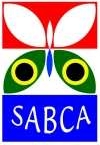 |
South African Butterfly
Conservation Assessment
(SABCA)
 |
| From
left to right: Alan Heath, Steve Woodhall, Rob Wolter (Conservation
Manager UNR) Richard Dobson, Nita Dobson. Photograph by: Ada
Kaliszewska |
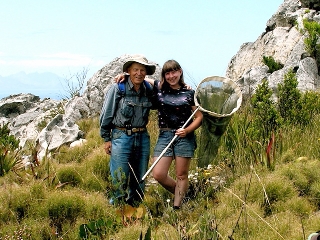 |
| Ada
Kaliszewska and Alan Heath searching for Chrysoritis and Thestor
Butterflies |
PRESS RELEASE MAY 2007
For
the launch of the
SOUTHERN
AFRICAN BUTTERFLY CONSERVATION ASSESSMENT (SABCA)
Pretoria,
14 May 2007
“Butterfly
conservation gets wings”
A
four-year conservation project aimed at determining the distribution
and
conservation priorities of all butterfly species in the South African
region,
especially those threatened with extinction, was launched on 14 May
2007 at
the Pretoria Botanical Gardens. “South Africa has a unique and wealthy
butterfly fauna,” says Hermann Staude, President of the Lepidopterists'
Society
of Africa. “But of our 671 known butterfly species, two and possibly
three
species have become extinct! A further 38 species are listed in the Red
Data
List, meaning they are threatened with extinction in the near future.”
The
Project Coordinator for the Southern African Butterfly Conservation
Assessment
(SABCA), Silvia Mecenero, adds: “Unless South Africa pays careful
attention to
the conservation of our butterflies now, we could lose many more of
these
fascinating creatures as well as the important services they provide to
our
ecosystems.” “SABCA will help us to fill in the many gaps in our
knowledge of
butterflies and their threats. With this information we can make sure
that we
implement the correct conservation actions to prevent more
extinctions,” says
SANBI Threatened Species Programme Manager, Wendy Foden Because
butterflies
tend to rely on particular host plant species for food, they are
particularly
vulnerable to the transformation of natural lands. The destruction of
natural
vegetation for agriculture, urbanization and infrastructure is the main
cause
of butterfly declines and extinctions. Butterflies are also known to be
particularly sensitive to climatic changes as a result of global
warming. Three
leading institutions have created a significant partnership to
implement SABCA,
namely the South African National Biodiversity Institute (SANBI), the
Lepidopterists' Society of Africa (LepSoc) and the University of Cape
Town's
Avian Demography Unit (ADU). Nature conservation authorities,
universities,
museums, amateur lepidopterists and members of the public have been
part of the
planning and strategizing that have brought SABCA into being. SABCA
aims to train
and educate previously disadvantaged groups to promote butterfly
conservation.
The public will also have opportunities to participate in this
important
project. The project is co-funded by the Norwegian Ministry for the
Environment
and SANBI through their Environment Cooperation Programme. SANBI is a
statutory
body under the Department of Environmental that have brought SABCA into
being.
SABCA aims to train and educate previously disadvantaged groups to
promote
butterfly conservation. The public will also have opportunities to
participate
in this important project. The project is co-funded by the Norwegian
Ministry
for the Environment and SANBI through their Environment Cooperation
Programme.
SANBI is a statutory body under the Department of Environmental Affairs
and
Tourism and is responsible for fulfilling the new Biodiversity Act
mandate to
monitor and report on the state of South Africa's threatened
biodiversity.
SABCA is the first major project on insects to be undertaken by SANBI.
SABCA is
coordinated by the ADU, which is experienced in running atlas projects,
having
successfully coordinated the bird and frog atlas projects. The ADU is
also
coordinating the Southern African Reptile Conservation Assessment
(SARCA).
LepSoc is an amateur society that was formed 24 years ago to encourage
the
study and conservation of butterflies and moths in Africa. LepSoc will
be
responsible for the collection of butterflies in the field, as well as
providing expertise in identification of butterflies. LepSoc has
already been
involved in the proclamation of at least four conservation areas for
specific
butterfly species, including for the Critically Endangered Brenton Blue
butterfly. Butterflies are one of the most diverse groups of insects,
and play
an important ecological role by pollinating flowering plants. In South
Africa,
the Mountain Pride Butterfly
is known to be the only pollinator of several red
flowering plants, such as the charismatic red “Pride of Table Mountain” Orchid
(Disa uniflora). Butterflies in the Lycaenid family in South
Africa are mostly
endemic and do not occur anywhere else in the world. South Africa has
one of
the highest proportions of Lycaenid butterflies (48%) for any region in
the
world. Of the 38 threatened butterfly species included in the proposed
Red Data
Book, about 90% are Lycaenids. These butterflies have life cycles that
are
closely linked with specific plant and ant species and many only occur
in very
small, confined areas.
How
can the public get involved in SABCA?
Previous
atlas projects for birds, frogs and reptiles, show that the public can
play an
extremely useful role in species conservation. Anyone can become
involved in
SABCA in any of three ways:
1)
SABCA urges members of the public to take digital photographs of the
butterflies (at any of their life stages i.e. caterpillars, pupae or as
adult
butterflies) they see in gardens, on holiday and those killed on the
roads.
Together with the details of where they were taken, these photographs
can be
submitted to the :
Project's
website “Virtual Museum”. Records that are of good quality will be
entered into
a butterfly database and will be available for use as an educational
resource
to all.
2)
Volunteers can join the SABCA team on field trips into previously
poorly
studied areas to collect butterflies and information about the
butterfly habits
and habitats.
3)
People with private butterfly collections are encouraged allow the
project's
data capturers to identify and record the species in the collections
and the
areas and dates of collection. For more information on SABCA and on how
to
participate, visit the project website: http://butterflies.adu.org.za.
NOTES
FOR EDITORS
Where
will SABCA operate?
SABCA
aims to determine the distribution of all butterfly species in South
Africa,
Lesotho and Swaziland thereby providing information for the
conservation of
this group of insects, especially those that are endangered.
What
is a conservation assessment?
A
conservation assessment describes the likelihood of a species becoming
extinct,
and is the basis for Red Data lists. Species listed as Critically
Endangered,
Endangered or Vulnerable (collectively referred to as "Threatened”
species) are those that are assessed as having a high risk of
extinction in the
near future. Conservation assessments highlight species and areas of
significant conservation importance, providing baseline information
that is
needed for conservation planning.
What
is a conservation assessment?
A
conservation assessment describes the likelihood of a species becoming
extinct,
and is the basis for Red Data lists. Species listed as Critically
Endangered,
Endangered or Vulnerable (collectively referred to as "Threatened”
species) are those that are assessed as having a high risk of
extinction in the
near future. Conservation assessments highlight species and areas of
significant conservation importance, providing baseline information
that is
needed for conservation planning. The first butterfly Red Data book was
published in 1989. This book is currently being updated by a group of
biologists who helped to found SABCA. However, large gaps still exist
in our
knowledge of butterflies, and these must be filled SABCA, so that the
appropriate conservation management actions can be taken for the
threatened
species.
Butterfly
facts and figures
·
Butterflies are insects, which make up the most species-rich group of
animals
on the planet.
·
There are about 4000 butterfly species in Africa. South Africa provides
a home
for almost 17% of that
total.
·
South Africa has a total of 671 butterfly species in five families.
Thirty-eight of these species are listed in the Red Data book, i.e. are
threatened with extinction. Another two species have already become
extinct.
·
Butterflies are the only insects well served by guide books.
Butterflies
in our ecosystems
·
The presence and composition of butterfly communities is an excellent
indicator
of overall ecosystem health.
·
One of the most important roles of butterflies is the pollination of
flowering
plants. For example, the Mountain Pride butterfly is the only known
pollinator
of several plants with red flowers, including the charismatic red
“Pride of
Table Mountain” orchid (Disa uniflora).
·
Butterflies are easy to see and generally easy to identify with a
little
effort.
·
Butterflies add to the tourism potential of South Africa.
·
Butterflies are wonderful tools for education.
·
Habitat destruction is the primary reason that some butterfly
populations in
South Africa are declining.
A
special butterfly group: the Lycaenidae
·
South African butterflies in the family Lycaenidae are mainly only
found in
South Africa and in no other country (i.e. are endemics).
·
About 7% of the butterfly species in this group are threatened with
extinction
and are listed in the butterfly Red Data book.
·
Lycaenids mainly occur in very small and limited areas because they are
usually
associated with specific host plants and host ants to complete their
life
cycle. Because of these characteristics, Lycaenids are easily
threatened by
habitat destruction.
·
Rapid land development in the Western Cape causes particular concern
because of
the approximate 236 butterfly species occurring in the province, more
than half
are Lycaenids.
·
The Brenton Blue butterfly in the Western Cape: This Lycaenid is
Critically
Endangered. It's conservation status is being researched by Dave Edge,
a member
of LepSoc. There are only 100 individuals of this
butterfly
within the Brenton Blue Butterfly Reserve. The population is in
decline, which
may be linked to weather conditions. Active management within the
reserve is
still necessary to maintain the butterfly's food plant. Attempts to
reintroduce
the butterfly to a site in Nature's Valley have not been successful.
Although the
site has been rehabilitated to provide the butterfly's food plant, the
host ant
is absent, which may be the reason that a butterfly population has not
yet
become established. The priority is now to establish the host ant at
the site
and to increase the food plant.
· The Winelands Blue and
the Coega Copper butterflies at Coega in the Eastern Cape, a large area
zoned
for industrial development: Both of these Lycaenids are Threatened,
because
they are extremely localised in their distribution and because they use
ants to
protect their larvae during their life cycles. Ernest Pringle of LepSoc
is
involved with the conservation of these butterflies at Coega. The
Winelands
Blue butterfly larvae feed for a short time on the host plant, then
they are
taken underground by Campnotus ants. Once underground, the butterfly
larvae become
carnivorous and feed on the larvae and pupae of the ants. The Coega
Copper
female butterfly lays eggs in loose sand close to nests of Lepisiota ants. The life history of this
butterfly is difficult to track because of their secretive behaviour.
Four areas
have been and will be cordoned off from development at Coega, one to
create a
reserve for the Winelands Blue, and the other three for the Coega
Copper. All
these areas are being closely monitored and the exotic invasive plants
have been
removed by the Coega Development Corporation underground, the butterfly
larvae
become carnivorous and feed on the larvae and pupae of the ants. The
Coega
Copper female butterfly lays eggs in loose sand close to nests of
Lepisiota
ants. The life history of this butterfly is difficult to track because
of their
secretive behaviour. Four areas have been and will be cordoned off from
development at Coega, one to create a reserve for the Winelands Blue,
and the
other three for the Coega Copper. All these areas are being closely
monitored
and the exotic invasive plants have been removed by the Coega
Development
Corporation
The Amakosa
Rocksitter
spp (Durbania amakosa albescens)
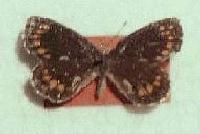 |
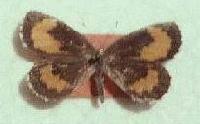 |
| Durbania amakosa albescens - Male | Durbania amakosa albescens - Female |
This butterfly is on the wing from December to January, and only three small colonies of this sub-species have ever been found. This is an intriguing small butterfly, which can be very easliy overlooked unless it is being specifically searched for. The rocksitter is very reluctant to fly even when approached, and will remain immobile for long periods. When they settle on a rock they have they habit of walking backwards towards the ground. The underside of the butterfly resembles the background, thus giving it perfect camouflage.
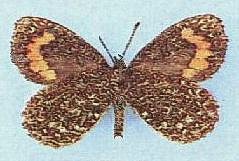 |
| Durbania amakosa albescens - Female underside |
The female butterfly lays her eggs on lichen covered rocks. The lichen is also the host on which the caterpillars feed on. The caterpillars also pupate in cracks and crevices on the side of the rocks, usually a little way above the level of the soil. They are more often than not concealed behind grass, growing around the rocks. The whole life-cycle of the Amakosa Rocksitter occurs on the lichen covered rocks, the butterfly only flying off when it is searching for a mate. It is sad to note that the survival of this sub-species is under threat, due to housing development projects.
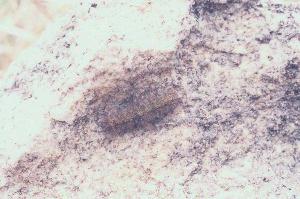 |
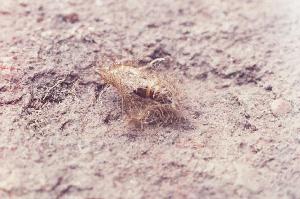 |
| Durbania amakosa albescens - Larvae | Durbania amakosa albescens - Pupae |
A survey of butterflies of the Mpenjati Nature Reserve, took place from the 1st of October, 2003 to the 30th of September, 2004. The objective here, was to obtain initial data on the composition of the butterfly fauna, and to elaborate the first ever checklist for the reserve. (Click on the button for the full report, which is in PDF format).
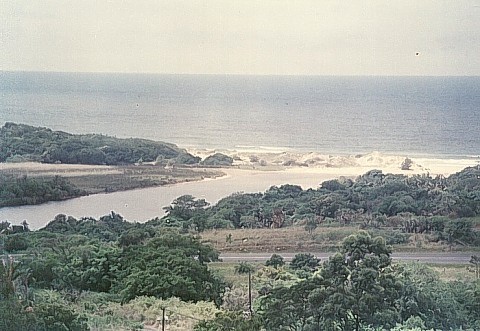 |
| Photograph of the Mpenjati Nature Reserve - Palm Beach - KwaZulu Natal |
With the introduction of ; "Invasive Alien Invader Plants", which have either been introduced deliberately or accidently, have now become the prefered host plants for several species of butterflies. These alien invaders are capable of invading stable natural vegetation. They are on the increase and have caused irreversable changes to natural plant cover in some area's. These plants are also aggressive growers, the seeds can also lie dormant for up to 50 years. Survival of a butterfly species depends on the success of the habitat meeting the species unique requirements. These requirements include an adequate food supply for the larvae, as well as; "Nectar" plants, for the adult butterflies to feed on. Indiscriminate removal of these aliens from an area could also lead to the extinction of that particular butterfly colony, due to the fact that no thought is given to replace these plants with a suitable alternative. Studies are currently being conducted by using butterflies as a means of controlling these alien plants, natutally.
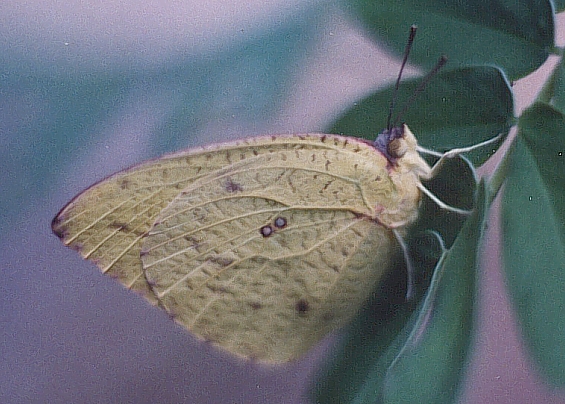 |
| Catopsilia florella - Female on host plant "Peanut Butter Cassia", (Senna didymobotrya). |
An example of this is the; "African Migrant", (Catopsilia florella), which now has a preference for the "Peanut Butter Cassia", (Senna didymobotrya). Which the butterfly uses as a food plant for it's larvae to feed on.
 |
| Catopsilia florella - Male |
This butterfly can be found on the wing throughout the year. The eggs are laid singly on its host plant. The eggs are long and tapered, and can be easily seen on the leaves of the host plant. This species of butterfly can be found throughout southern africa, and it is also a very common insect.